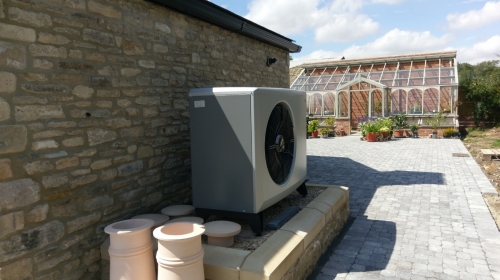How does an Air Source Heat Pump work?
In simple terms imagine a fridge but in reverse, instead of it moving the heat from inside of the fridge to outside, it collects the heat from the outside air and moves it inside to heat the property.
Air Source Heat Pumps work like a ground source heat pump as it compresses the collected heat, but the system’s energy source is in the air instead of underground or in water. The fan draws a small amount of energy from the outside air into the heat pump and over the heat exchanger. The outside temperature does not have to be warm as some air source heat pumps work at low temperatures, even blow freezing. This might sound impossible, surely there is no warm air at -5oC. Well, given that the refrigerant used to collect the energy boils between -15oC and -30oC, there is always energy to be extracted regardless of the weather.
The air is blown over a refrigerant called glycol (antifreeze mixed with water) which turns the glycol liquid into a gas. This warmed gas is then passed into a compressor which increases the pressure of the gas, heating the gas further. The high-temperature compressed gas is then fed into your property’s central heating system to be used in the buffer tanks to supply heating and hot water. The cooled solution returns to a liquid state after releasing the and flows back to the heat pump to repeat the process.
What are the requirements to install an Air Source Heat Pump?
The initial requirement of any heat pump is to ensure that your property has a sufficient standard of insulation. If the building is draughty and heat is escaping rapidly then, even though a heat pump will reduce costs and is more efficient than a gas boiler, it will increase costs in electricity.
Properties that are well insulated will benefit more from a heat pump, as the heat created remains inside. Insulation is based on a scale and at a certain point, the heat pump will lose efficiency and increase running costs. Insulation standards can always be improved, doing so will help future proof your house, especially as the UK moves towards renewable heating.
Property owners looking to install an air source heat pump must consider the requirements of fitting the units. There must be substantial room outside the home to ensure consistent airflow for the heat pump. Avoiding any areas that may build up with debris like leaves is a bonus. Inside the home, there must be enough room to fit a water storage tank. The indoor spatial requirements will slightly increase if the pump is supplying both heating and hot water.
Do I need planning permission for an Air Source Heat Pump?
Over time, the government has made it easier and easier for homeowners to install renewable technology. Since 2011, the domestic installation of an air source heat pump hasn’t needed any application, given that it meets select requirements. These requirements can be found in the Microgeneration Certification Scheme Standards. However, it is always good practice to check first before starting the process. Ringing your local planning authority or a local MCS-certified installer can help clarify any potential grey areas. Planning permission will usually be required for listed buildings and homes located in certain conservation areas, it is best to contact your local authority.
There are a few conditions that will decide whether the air source heat pump is a permitted development:
- The first is that the installation must adhere to the MCS planning standards.
- There is only one ASHP being installed. More than one ASHP requires planning permission.
- The ASHP must only be used for heating, hot water, or both.
- The ASHP must be at least 1m away from the edge of your property.
- The volume of the ASHP compressor must not be over 0.6m3.
- The ASHP must be installed on a flat surface, be it the ground or roof. The unit can be elevated but it must be at least 1m away from the edge of elevation.
How much does an Air Source heat pump cost?
There are many different brands of air source heat pumps each varying in costs, this is increased in a project with other materials and designs for the system. Air source heat pumps can cost anywhere between £13,000 - £16,500 depending on the unit and pipework needed to connect the system. These units are typically more expensive as they are made to handle the UK’s damp climate, resulting in a larger heat exchanger inside the heat pump.
Do Air Source Heat Pumps work in winter?
Air Source Heat Pumps work well in the winter, the extent to which they are efficient depends on the unit installed. For example, the UK’s damp winter climate restricts the efficiency of air source heat pumps that are made for dryer winter climates. Those units will have much smaller heat exchangers making the heat pump less effective at removing any built-up ice. Air source heat pumps are equipped with the ability to remove this ice through a defrost cycle. Whilst this is a great solution to damper climates, it reduces the efficiency whilst costing more electricity to defrost the unit.
Part of the isoenergy service is to ensure that unit is designed to meet a select criterion, ensuring the unit installed is the best fit for the property. A simple factor is the position of the heat pump to avoid any snow/debris building up around the heat pump, causing potential freezing up through the winter period.
If you would like to know more or find out how we can help green your building, then be sure to contact our team on 01293 821 345. We are actively trying to increase the number of buildings with renewable technology, why not let us help you?







